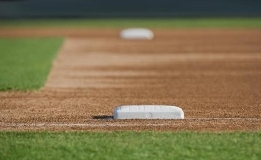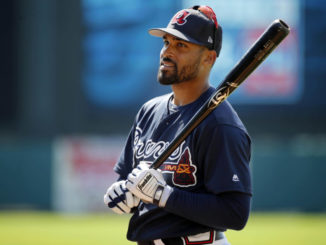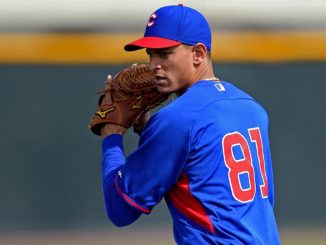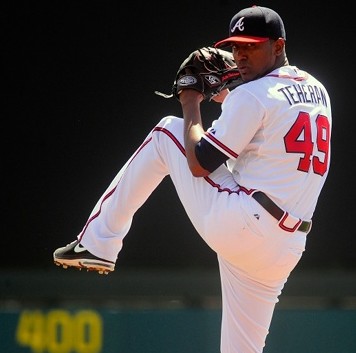Learning on the Fly: Advanced Metrics and Asking the Right Questions: Part 2
Sabermetrics 101 – OBP and wOBA
Alright, I’m starting to dig into the advanced stats that help paint the picture of a hitter. I’m taking baby steps with this, so if you’re a sabermetrics nerd, please bear with me as I go through this. This is an effort in learning as well as educating.
I’m going to look at On Base Percentage (OBP) and weighted On Base Average (wOBA).
On Base Percentage (OBP) –
On base percentage is a simple enough stat to calculate. This is used to see the rate at which a batter reaches base safely. To figure OBP, you divide hits-plus-walks-plus-hit by pitches, by, at bats-plus-walks-plus-hit by pitches-plus-sac flies.
Here’s an example: (30+16+4) / (68+16+4+6)=(50) / (94)= .532 (rounded up from .5319 … )
So in the example, a batter has 30 hits, 16 walks, and 4 HBP’s. That sum is 50. Next, we add in at bats and sacrifice flies. There are 68 at bats, 16 walks, 4 HBP’s, and 6 sacrifice flies for a total of 94. 50 divided by 94 gives you .5319 … this gets rounded up to .532. This particular batter reaches base in over half of his plate appearances that count as at bats.
It’s important to note, that OBP uses plate appearances as part of its formula, but plate appearances DO NOT count as at bats. An example would go like so:
A batter comes to the plate 10 times in a double header. He walks 5 times and gets a hit 3 times. His OBP (based on PA’s) is .800 or 8 out of 10 times to the plate. His batting average (based on at bats) is .600 because he has 3 hits in 5 at bats. The 5 walks count as plate appearances, but not at bats..
Therefore, a batter hitting perhaps maybe .236, but is getting on base over half the time, is really setting the table for runs to be scored. This speaks more accurately to the premise that a hitters’ primary job is to NOT make an out.
weighted On Base Average (wOBA) –
wOBA takes into consideration all aspects of hitting. This is a more comprehensive stat that more accurately gives the value of an individual batter.
Calculating wOBA isn’t as simple as OBP. Below is FanGraphs explanation of wOBA and its calculation:
“Weighted On-Base Average combines all the different aspects of hitting into one metric, weighting each of them in proportion to their actual run value. While batting average, on-base percentage, and slugging percentage fall short in accuracy and scope, wOBA measures and captures offensive value more accurately and comprehensively.” – FanGraphs
As stated, weights change from year to year. Fangraphs keeps a running table of weights dating back all the way to 1871. Each result (single, double, triple, etc.) has an annual average value. For 2016, the average wOBA is .317. In the below formula, uBB represents Unintentional Base on Balls (basically, walks).
“The wOBA formula for the 2013 season was:
wOBA = (0.690×uBB + 0.722×HBP + 0.888×1B + 1.271×2B + 1.616×3B +
2.101×HR) / (AB + BB – IBB + SF + HBP)” – Fangraphs
A quick explanation on weights, with some help from math-magician and simplifying expert, Chris:
Each event (1B, 2B, 3B, HR, BB, etc.) contributes more or less in scoring runs. In batting average, a 16 foot bunt single counts just the same as a 520-foot moon shot.
However, each count differently toward the contribution of runs. If we want to properly analyze a player’s offensive performance, we have to consider the difference in his different contributions.
Studying the scoring in each year, we can determine how often one of these events leads to a run scoring. Then we can use that factor to apply a weighted average.
You can see in the formula that each type of hit, and way to reach base, is given a value. Walks are least valuable, whereas home runs are the highest. This makes sense, since each category is of more value.
The biggest difference from OBP and wOBA is that, while you could draw the same conclusion, wOBA represents more of a player’s ability to contribute to run scoring. An OBP doesn’t differentiate between doubles or triples like wOBA does. It accounts for each type of “hit” individually.
The key here is counting extra base hits as they are, not as a one base hit, which still ties into the hitter’s ability to not make an out. How you use wOBA is actually fairly simple. League average wOBA is scaled to the league average OBP. To know a good OBP, is also to know a good wOBA.
To my understanding, wOBA is a more intricate, effective way of analyzing a hitter’s production. Going back to the point of getting on base, wOBA is used in conjunction with OBP, and tells a more precise story of a particular batter in terms of scoring runs.
For more in-depth details on wOBA, you can go to FanGraphs page on the essentials to wOBA.
On Deck –
That’s about the maximum capacity for my head to process all these numbers. I’m not a mathematical wizard. I do better with letters, in the form of words, that create complete sentences.
Next time, I’ll look at On Base and Slugging Percentage Plus (OPS+), Run Expectancy 24 Base Out State (RE24), and if I have the capacity for more, I’ll look at Win Probability Added (WPA) and Run Expectancy 24 Base Out State (RE24); a contextual based stat.





Leave a Reply